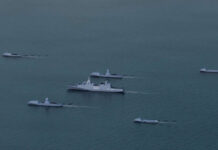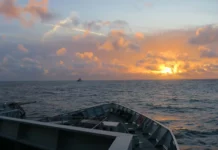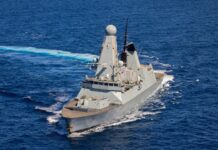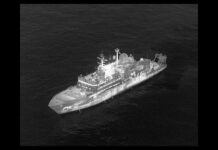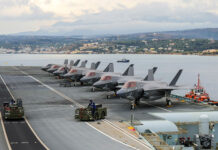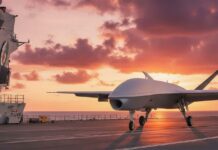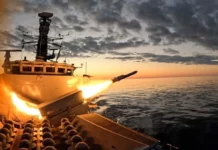The UK Ministry of Defence (MoD) published a summary of its work under the Anti-Submarine Warfare (ASW) Spearhead programme on 1 October 2025.
A collaboration between the Royal Navy, defence industry and research organisations, the ASW Spearhead programme is a GBP 400 million (EUR 460 million) initiative that has rapidly delivered three autonomous platforms that will strengthen the UK’s naval capabilities.
The programme’s success, the UK MoD stated, “stems from a seven-step governance framework that prioritised speed without compromising safety”. This approach, championed by the MoD’s UK Defence Innovation (UKDI) organisation, “enabled rapid development while maintaining rigorous operational standards”, the MoD added.
Multi-year funding provided industry partners with the confidence to innovate and covered all development activities, ensuring that demonstrators could progress without traditional handover delays. The Defence Science Technology Laboratory (Dstl) provided technical support throughout the programme, acting as a cost-cutting enabler and participating in panels to assess capability proposals.
The first development under ASW Spearhead is Project Cetus, which has led to the development of a 12 m experimental vessel that is currently the Royal Navy’s largest autonomous underwater vehicle (AUV). Originally funded through a Dstl and Defence and Security Accelerator (DASA) project through the Submarine Delivery Agency (SDA), manufacturer MSubs delivered the GBP 15.4 million, 12-metre AUV in November 2022. At 25 tonnes with full payload, this AUV is billed by the MoD as “one of the most complex uncrewed submersibles used by any navy to date”.
The platform’s substantial payload bay enables diverse mission configurations, covering anti-submarine warfare, seabed operations and intelligence-gathering capabilities. Project Cetus will help the Royal Navy develop operational concepts for autonomous systems while addressing critical objectives including autonomous decision-making, advanced sensor miniaturisation, launch/recovery procedures and system security protocols. The platform began sea trials in February 2025 and on 15 May 2025 the Project Cetus extra-large uncrewed underwater vehicle was formally named XV Excalibur during a ceremony at His Majesty’s Naval base Devonport.
Project Proteus, meanwhile, produced a 3-tonne autonomous rotary-wing demonstrator developed by Leonardo Helicopters using an airframe derived from the AW09 single-engine multi-role helicopter.
Accelerating from initial requirements to hardware delivery within three years through innovative acquisition approaches, Project Proteus has produced a rotary-wing platform that serves as a testbed for autonomy and mission modularity, initially focusing on sonobuoy deployment and communications relay missions that are both critical to ASW operations.
“Proteus addresses critical dangerous missions while reducing reliance on expensive crewed helicopter operations, delivering significant cost savings and risk reduction,” the MoD stated. “Future capabilities will expand beyond sonobuoy operations to include logistics support, search-and-rescue co-ordination, and maritime surveillance missions.
The third deliverable under the ASW Spearhead programme is Project Scylla: is an autonomous torpedo tube launch and recovery system. The torpedo vehicle is designed to be launched, autonomously conduct missions and then recover itself back into a submarine torpedo tube, enhancing submarine capabilities without requiring platform modifications.
Scylla features a modular mid-section, which allows mission-specific payload configurations for diverse operational requirements. Trials from Royal Navy Astute-class nuclear-powered attack submarines (SSNs) began in 2024-25, with initial operating capability currently planned for 2026-27. The platform supports the objectives of AUKUS Pillar 2: advanced capabilities developed under the aegis of the AUKUS defence and security partnership between Australia, the United Kingdom and the United States announced in September 2021. It does this by providing submarines with deployable autonomous vehicles capable of seabed warfare, intelligence operations and covert surveillance missions.
“Scylla delivers a paradigm shift in ASW capabilities: the most significant since the introduction of Tomahawk,” Commander Chris Hill, the ASW Spearhead programme director, was quoted as saying by the UK MoD. “Working with AUKUS partners, development is underway on a range of seabed warfare and ISR [intelligence, surveillance and reconnaissance] payloads for this expeditionary capability.”
The MoD concluded that the three platforms developed under the ASW Spearhead programme “demonstrate how collaborative innovation accelerates capability development whilst reducing costs and risks”, adding that the ASW Spearhead programme “positions the Royal Navy at the forefront of autonomous naval warfare innovation while reducing operational risks, lifecycle costs, and supporting broader AUKUS partnership objectives.
“This success validates UKDI’s innovative approach, proving that streamlined governance and strategic partnerships can rapidly transform defence capabilities,” the MoD added.







